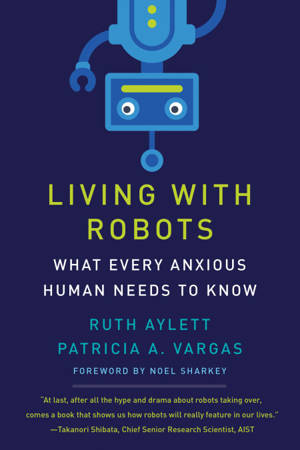
- Afhalen na 1 uur in een winkel met voorraad
- Gratis thuislevering in België vanaf € 30
- Ruim aanbod met 7 miljoen producten
- Afhalen na 1 uur in een winkel met voorraad
- Gratis thuislevering in België vanaf € 30
- Ruim aanbod met 7 miljoen producten
Zoeken
Living with Robots E-BOOK
What Every Anxious Human Needs to Know
Ruth Aylett, Patricia A. Vargas
E-book | Engels
€ 21,63
+ 21 punten
Uitvoering
Omschrijving
THE TRUTH ABOUT ROBOTS: Two robotics experts look beyond the hype, offering a lively and accessible guide to what robots can (and can’t) do.
There’s a lot of hype about robots; some of it is scary and some of it utopian. In this accessible book, two robotics experts reveal the truth about what robots can and can’t do, how they work, and what we can reasonably expect their future capabilities to be. It will not only make you think differently about the capabilities of robots; it will make you think differently about the capabilities of humans.
Find out:
• Why robots can swim and fly but find it difficult to walk
• Which robot features are inspired by animals and insects
• Why we develop feelings for robots
• Which human abilities are hard for robots to emulate
Ruth Aylett and Patricia Vargas discuss the history of our fascination with robots—from chatbots and prosthetics to autonomous cars and robot swarms. They show us the ways in which robots outperform humans and the ways they fall woefully short of our superior talents. They explain how robots see, feel, hear, think, and learn; describe how robots can cooperate; and consider robots as pets, butlers, and companions. Finally, they look at robots that raise ethical and social issues: killer robots, sexbots, and robots that might be gunning for your job. Living with Robots equips readers to look at robots concretely—as human-made artifacts rather than placeholders for our anxieties.
There’s a lot of hype about robots; some of it is scary and some of it utopian. In this accessible book, two robotics experts reveal the truth about what robots can and can’t do, how they work, and what we can reasonably expect their future capabilities to be. It will not only make you think differently about the capabilities of robots; it will make you think differently about the capabilities of humans.
Find out:
• Why robots can swim and fly but find it difficult to walk
• Which robot features are inspired by animals and insects
• Why we develop feelings for robots
• Which human abilities are hard for robots to emulate
Ruth Aylett and Patricia Vargas discuss the history of our fascination with robots—from chatbots and prosthetics to autonomous cars and robot swarms. They show us the ways in which robots outperform humans and the ways they fall woefully short of our superior talents. They explain how robots see, feel, hear, think, and learn; describe how robots can cooperate; and consider robots as pets, butlers, and companions. Finally, they look at robots that raise ethical and social issues: killer robots, sexbots, and robots that might be gunning for your job. Living with Robots equips readers to look at robots concretely—as human-made artifacts rather than placeholders for our anxieties.
Specificaties
Betrokkenen
- Auteur(s):
- Uitgeverij:
Inhoud
- Aantal bladzijden:
- 312
- Taal:
- Engels
Eigenschappen
- Productcode (EAN):
- 9780262365475
- Verschijningsdatum:
- 20/09/2021
- Uitvoering:
- E-book
- Beveiligd met:
- Adobe DRM
- Formaat:
- ePub

Alleen bij Standaard Boekhandel
+ 21 punten op je klantenkaart van Standaard Boekhandel
Beoordelingen
We publiceren alleen reviews die voldoen aan de voorwaarden voor reviews. Bekijk onze voorwaarden voor reviews.








